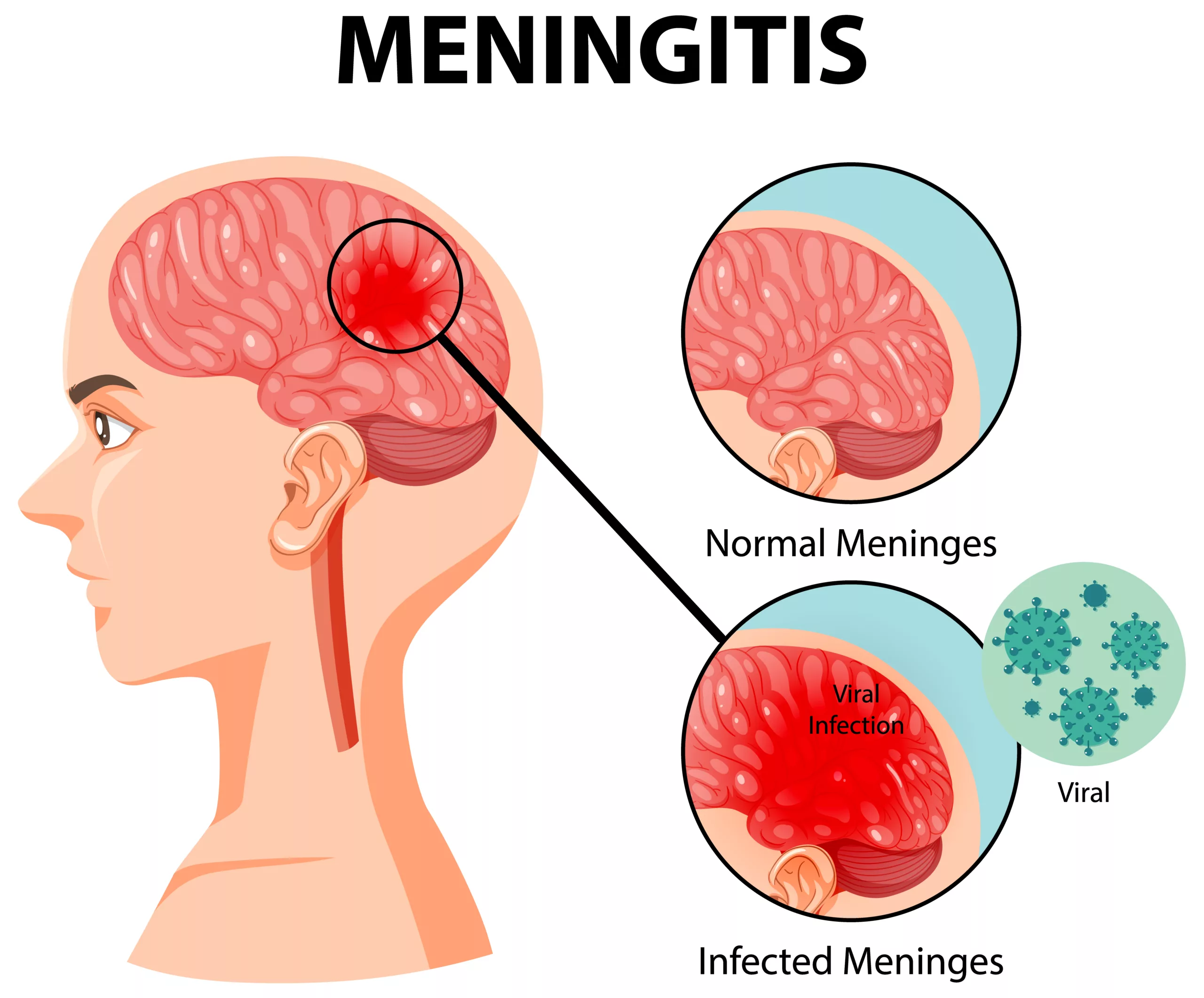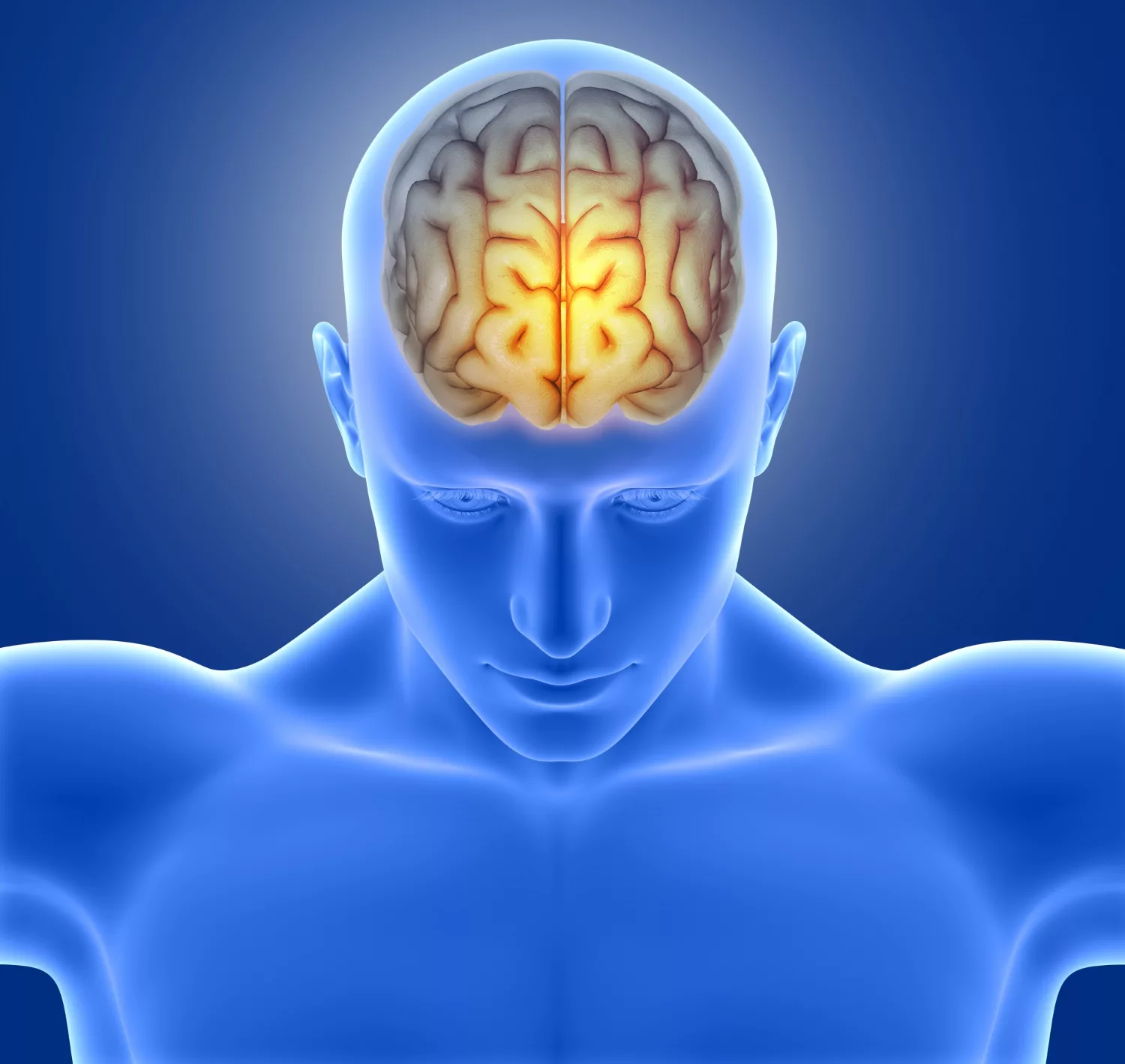Viral Meningitis is a type of Meningitis that primarily results from viral infections. It often begins suddenly with symptoms like fever, headache, light sensitivity, neck stiffness, and sometimes nausea and vomiting. In young children, however, signs of meningeal irritation may not always be present.1Wright WF, Pinto CN, Palisoc K, Baghli S. Viral (aseptic) meningitis: A review. J Neurol Sci. 2019 Mar 15;398:176-183. The central nervous system encompasses crucial organs, namely the brain and spinal cord, shielded by three protective layers known as the meninges (Dura mater, arachnoid mater, and Pia mater). Additionally, the cerebrospinal fluid (CSF) circulates through the brain and spinal cord, contributing to their protection and functioning.

Meningitis occurs when the meninges become inflamed, typically due to a bacterial or viral infection in the CSF. Viral Meningitis stands as the most prevalent type among the various forms of Meningitis.2McGill F, Griffiths MJ, Solomon T. Viral meningitis: current issues in diagnosis and treatment. Curr Opin Infect Dis. 2017 Apr;30(2):248-256. Fortunately, the symptoms of viral Meningitis are generally less severe than other forms of the condition. It can affect individuals of all ages, regardless of gender or ethnicity.3Centers for Disease Control and Prevention. (2023). *About viral meningitis.* Retrieved from https://www.cdc.gov/meningitis/about/viral-meningitis.html
People who are at an Increased Risk of Meningitis
Viral meningitis usually resolves itself on its own, sometimes even without treatment. However, some people with weakened immunity may have a more severe illness. This may be due to:
- Immunodeficiency caused by HIV
- Chemotherapy treatment for cancer
- Transplant patients on immunosuppressants
- Children under five years of age
Causes of Viral Meningitis
The most common cause of viral Meningitis is non-polio enteroviruses (Coxsackie or Echovirus groups).4Rudolph H, Schroten H, Tenenbaum T. Enterovirus Infections of the Central Nervous System in Children: An Update. Pediatr Infect Dis J. 2016 May;35(5):567-9. Other rarer causes include the following families of viruses:
- Herpes Viruses (including Herpes Simplex, Epstein Barr virus, and Varicella-zoster Viruses)
- Mumps Virus
- Measles Virus
- Arbo Virus (like the West Nile Virus, Zika, Chikungunya, etc)
- Influenza Virus
- HIV
How does Viral Meningitis Spread?
Viral agents that cause Meningitis infect many people, but not all get the disease. However, they may act as reservoirs of infection. Hence, the virus may spread to other people who come into close contact with them. This may lead to their families and friends getting the disease. The mode of transmission will depend on the causative agent.
- This means contacting infected respiratory secretions such as saliva, nasal mucus, or sputum for enteroviruses.
- Mumps and Influenza will spread via respiratory droplets.
- Arbo viruses spread via infected arthropods (insects)
- Herpes viruses spread depending on the specific virus sg: HSV-1 spreads via contact with the virus from sores, saliva, etc.
- HIV is transmitted sexually or through infected syringes or other body fluids.
Symptoms of Viral Meningitis
Viral Meningitis and bacterial meningitis symptoms are similar. However, bacterial Meningitis is more severe. In fact, Bacterial Meningitis has more serious complications and may even be fatal, while is rarely fatal. Viral Meningitis may have different presentations depending on the age group.5 Logan SA, MacMahon E. Viral meningitis. BMJ. 2008;336(7634):36-40. doi:10.1136/bmj.39409.673657.AE
Typical viral meningitis symptoms commonly seen in infants:
- Elevated body temperature/ fever
- Restlessness
- Decreased appetite and lack of energy
- Drowsiness or difficulty waking up
Symptoms commonly seen in viral Meningitis affecting children and adults
- Headache: Persistent and severe headaches are a hallmark of Meningitis, often accompanied by sensitivity to light (photophobia) and sound (phonophobia).
- Fever: A high fever is typical in viral meningitis cases, indicating the body’s immune response to the viral infection.
- Stiff Neck: Neck stiffness and discomfort when bending the neck forward are classic signs of meningeal irritation.
- Nausea and Vomiting: Gastrointestinal symptoms, such as nausea and vomiting, may be present due to the inflammatory response.
- Photophobia: Bright lights can exacerbate headaches and discomfort, leading to photophobia in affected individuals.
- Phonophobia: Sensitivity to loud noises or sounds, known as phonophobia, may be experienced by those with viral Meningitis.
- Rash: Some viral infections may cause a rash that appears on the skin and mucous membranes, providing a clue to the underlying cause.
Light sensitivity, drowsiness, or difficulty waking up in children or adults are early warning signs of Meningitis.6Meningitis Foundation | Know the Symptoms | Disease | New Zealand. The Meningitis Foundation. https://www.meningitis.org.nz/know-the-symptoms#:~:text=A%20sensitivity%20to%20light%2C%20or If other symptoms accompany this, immediately consult your doctor. Your physician can confirm whether you have the disease, the causative agent, and the best treatment regimen.
How is Viral Meningitis Diagnosed?
Diagnosing viral Meningitis requires a comprehensive evaluation of the patient’s symptoms, medical history, and physical examination. Your physician might order the following diagnostic tests to confirm the diagnosis:
- Lumbar Puncture (Spinal Tap): A lumbar puncture involves obtaining a sample of cerebrospinal fluid (CSF) through a needle inserted into the lower back. Analysis of the CSF can reveal an increase in white blood cells, elevated protein levels, and normal to slightly decreased glucose levels, which are characteristic of viral Meningitis. Imaging is recommended before a lumbar puncture if there are signs like neurological abnormalities, papilledema, ongoing seizures, or a Glasgow Coma Score below 12.7MSD Manuals. (2023). Viral meningitis. Retrieved from https://www.msdmanuals.com/home/brain-spinal-cord-and-nerve-disorders/meningitis/viral-meningitis
- Viral PCR Test: Polymerase chain reaction (PCR) tests can detect the presence of viral genetic material in the CSF, helping identify the specific virus causing the infection.
- Blood Tests: Your doctor may perform blood tests to rule out other potential causes of the symptoms and determine the patient’s overall health status.
- Imaging Studies: In some cases, imaging studies such as magnetic resonance imaging (MRI) or computed tomography (CT) scans may be conducted to assess the brain and rule out other conditions.
How is Viral Meningitis Treated?
Unlike bacterial Meningitis, which requires immediate and aggressive antibiotic treatment, viral Meningitis often resolves independently with supportive care. Most people recover in 7 to 10 days.
Supportive measures may include:
- Bed Rest: Resting allows the body to fight the viral infection effectively and aids in the recovery process.
- Pain Management: Over-the-counter pain relievers such as acetaminophen or ibuprofen can help alleviate headaches, fever, and body aches.
- Hydration: Ensuring adequate hydration prevents dehydration, especially if fever and vomiting occur.
- Dark and Quiet Environment: Minimizing exposure to bright lights and loud noises can alleviate symptoms of photophobia and phonophobia.
Antivirals may help with certain diseases. For instance, your physician may prescribe:
- Acyclovir, for herpes simplex or herpes zoster
- Pleconaril for enteroviruses (moderate efficacy, not routinely prescribed)
- Antiretrovirals for HIV
People with severe illness or high-risk individuals may require hospitalization. Generally, your physician will treat you with antibiotics for bacterial Meningitis until they rule this out with negative cultures. Antibiotics work against bacteria and, hence, will be ineffective against Viral Meningitis.
Precautions for Meningitis
The best way to be safe from Viral Meningitis is to be vaccinated against the causative organism. Unfortunately, meningitis vaccines are not available for the relatively common Non-polio enteroviruses. However, MMR vaccines are available for Mumps and Measles.
Vaccines against Influenza and Chickenpox are also available. So, to protect your child from Viral Meningitis, ensure their vaccinations are on schedule. Moreover, meningitis vaccines are also available for some bacterial causes.
You can also take proactive steps to prevent infection from viruses that cause Meningitis, for example:
- Wash your hands with soap and water for at least 20 seconds.
- Clean and disinfect surfaces that are frequently touched by others.
- Avoiding close contact with people who are sick.
- Staying at home when you are ill. This includes keeping sick children out of school.
What is Aseptic Meningitis?
Aseptic meningitis is distinguished by cerebrospinal fluid (CSF), which tests negative for Gram stain and culture. There is an absence of a systemic illness or infection near the meninges. It has a generally positive clinical outcome. Generally, viruses are the most common cause. Nonetheless, this term covers over 100 possible causes, including other infections (such as mycobacteria, fungi, and spirochetes), para meningeal infections, medications, and malignancies.8UpToDate. www.uptodate.com. Accessed May 31, 2023. https://www.uptodate.com/contents/aseptic-meningitis-in-adults#:~:text=Patients%20with%20aseptic%20meningitis%20often
What is Cryptococcal Meningitis?
Cryptococcosis, an opportunistic fungal infection, kills over 100,000 HIV patients yearly. This infection, however, can occur in other immunocompromised situations, such as patients receiving immunosuppressive therapy. When the fungus Cryptococcus spreads from the lungs to the brain, it causes Cryptococcal Meningitis.9A M, Bicky Thapa. Meningitis, Cryptococcal. Nih.gov. Published May 11, 2019. https://www.ncbi.nlm.nih.gov/books/NBK525986/
Is Meningitis always associated with a rash?
No, Meningitis that appears with a rash has very few specific causes. There are two types of meningitis rashes:
- The petechial rash, which appears as red or purple pinpricks that can resemble flea bites
- The purpuric rash appears as reddish-purple blotches on the skin.
The rash can be caused by Meningococcal bacteria. Generally, the glass test is conducted for diagnoses. Basically, glass is pressed against the rash on the skin, and if you can see the rash through the glass, it is most likely a meningococcal rash.10Carter K. What is the “meningitis rash”? | Meningitis Research Foundation. www.meningitis.org. Published March 2019. https://www.meningitis.org/blogs/what-is-the-meningitis-rash
Difference between Encephalitis and Meningitis
Meningitis is the inflammation of the membranes, which enclose the brain and spinal cord. On the other hand, encephalitis refers to inflammation within the brain. Both encephalitis and Meningitis can arise from either infectious or non-infectious causes. Fever, headache, vomiting, photophobia, and a stiff neck characterize aseptic Meningitis. Normally, encephalitis symptoms include altered consciousness, seizures, and focal deficits.11Greenberg SB. Viral Meningitis and Encephalitis. Office Practice of Neurology. 2003;466-469. doi:10.1016/B0-44-306557-8/50066-6
Conclusion
Viral Meningitis is the most common form of Meningitis, caused by viral infections that lead to inflammation of the meninges. While it tends to be less severe than bacterial Meningitis, viral Meningitis can still cause discomfort and complications, requiring proper medical evaluation and care. Early recognition of symptoms, prompt diagnosis, and supportive care are essential for a favorable outcome. By understanding the causes, symptoms, diagnosis, and preventive measures associated with viral Meningitis, we can foster awareness and promote effective healthcare practices to mitigate its impact on public health.
Refrences
- 1Wright WF, Pinto CN, Palisoc K, Baghli S. Viral (aseptic) meningitis: A review. J Neurol Sci. 2019 Mar 15;398:176-183.
- 2McGill F, Griffiths MJ, Solomon T. Viral meningitis: current issues in diagnosis and treatment. Curr Opin Infect Dis. 2017 Apr;30(2):248-256.
- 3Centers for Disease Control and Prevention. (2023). *About viral meningitis.* Retrieved from https://www.cdc.gov/meningitis/about/viral-meningitis.html
- 4Rudolph H, Schroten H, Tenenbaum T. Enterovirus Infections of the Central Nervous System in Children: An Update. Pediatr Infect Dis J. 2016 May;35(5):567-9.
- 5Logan SA, MacMahon E. Viral meningitis. BMJ. 2008;336(7634):36-40. doi:10.1136/bmj.39409.673657.AE
- 6Meningitis Foundation | Know the Symptoms | Disease | New Zealand. The Meningitis Foundation. https://www.meningitis.org.nz/know-the-symptoms#:~:text=A%20sensitivity%20to%20light%2C%20or
- 7MSD Manuals. (2023). Viral meningitis. Retrieved from https://www.msdmanuals.com/home/brain-spinal-cord-and-nerve-disorders/meningitis/viral-meningitis
- 8UpToDate. www.uptodate.com. Accessed May 31, 2023. https://www.uptodate.com/contents/aseptic-meningitis-in-adults#:~:text=Patients%20with%20aseptic%20meningitis%20often
- 9A M, Bicky Thapa. Meningitis, Cryptococcal. Nih.gov. Published May 11, 2019. https://www.ncbi.nlm.nih.gov/books/NBK525986/
- 10Carter K. What is the “meningitis rash”? | Meningitis Research Foundation. www.meningitis.org. Published March 2019. https://www.meningitis.org/blogs/what-is-the-meningitis-rash
- 11Greenberg SB. Viral Meningitis and Encephalitis. Office Practice of Neurology. 2003;466-469. doi:10.1016/B0-44-306557-8/50066-6





